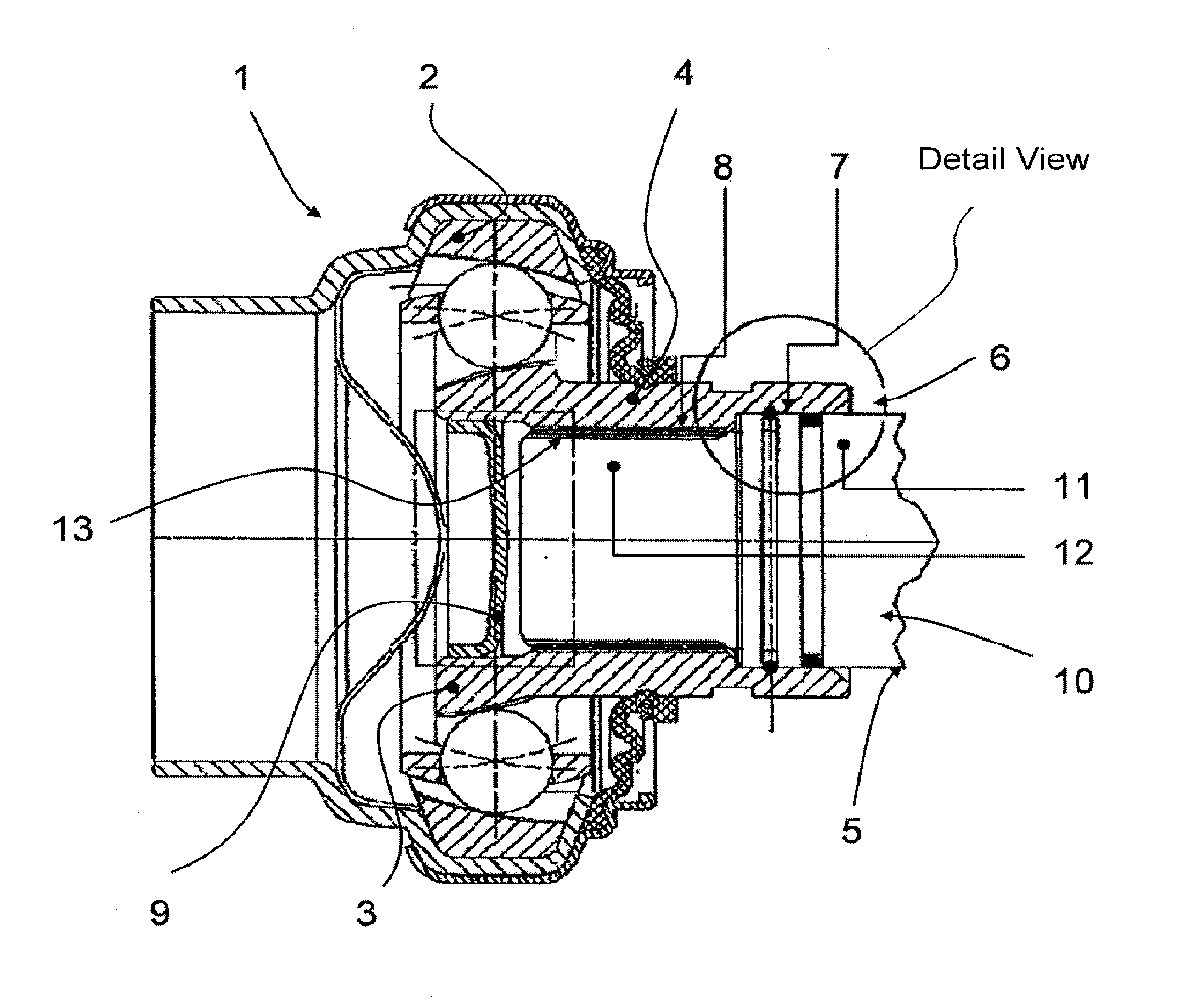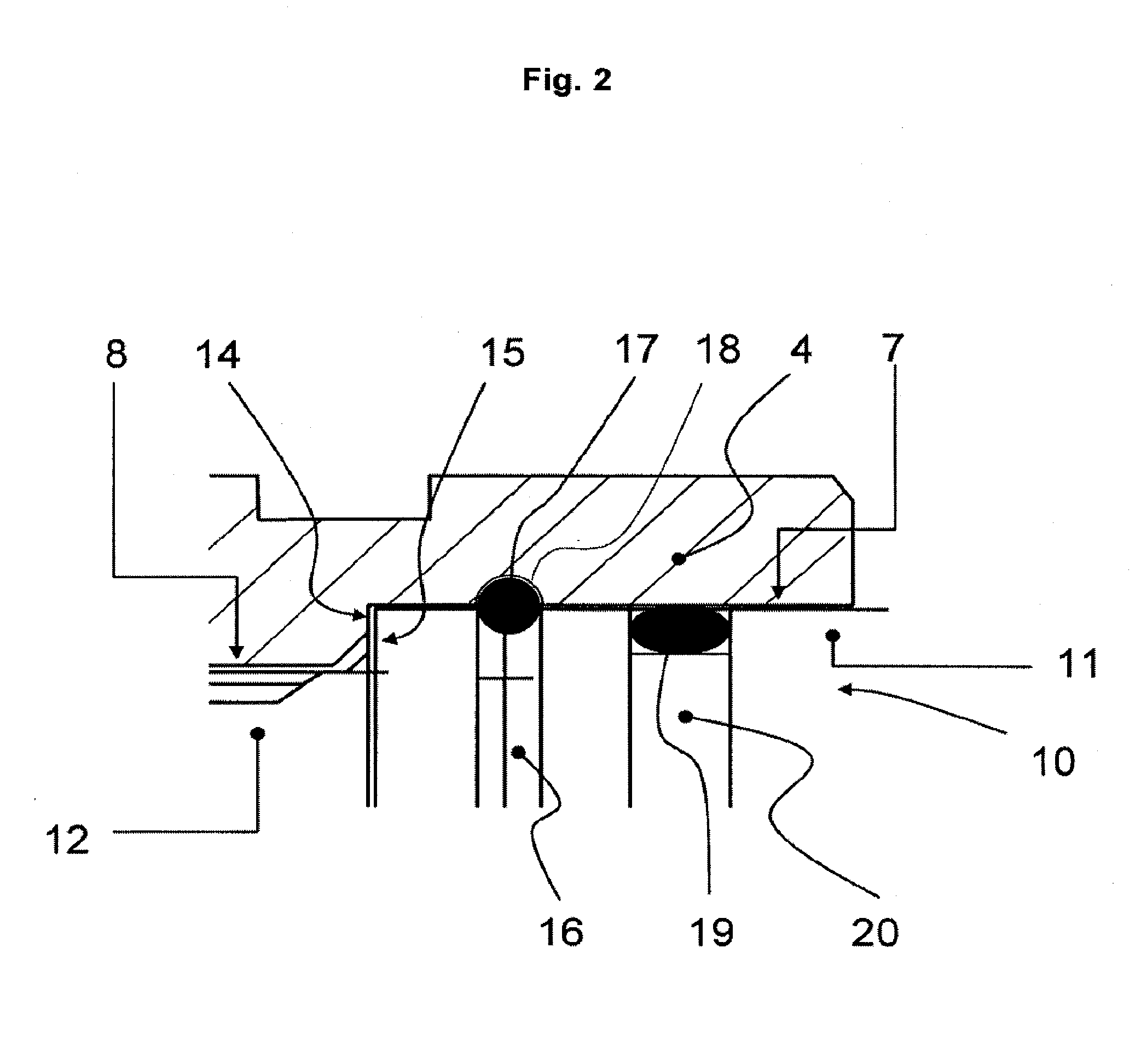[0008]Another object of the invention is to provide a system for connecting a shaft to a joint, which system firstly protects the shaft from being pressed past its intended position during the
assembly operation or during operation and which ensures a secure positioning of the retaining ring.
[0009]A further object of the invention is to provide a system for connecting a shaft to a joint which system also simultaneously exhibits improvements in terms of its weight, installation space and ease of assembly.
[0010]According to the invention, these and other objects of the invention are achieved substantially in that the sleeve comprises a central opening comprising a shaft-side first opening section, the internal
diameter of which is larger than that of a joint-side second opening section disposed in the direction of
insertion, a first radial stop section being provided between the first opening section and the second opening section. This first radial stop section extends at least substantially at right angles to the longitudinal axis of the sleeve. Similarly, the shaft journal comprises a shaft-side first shaft-journal section, the external
diameter of which is larger than that of a joint-side second shaft-journal section, a second radial stop section being provided between the first shaft-journal section and the second shaft-journal section in the form of a counter-stop for delimiting the insertion path of the shaft journal in the sleeve. Likewise, this second radial stop section extends at least substantially at right angles to the longitudinal axis of the shaft journal. When, for example, the shaft journal, which may be formed integrally with the shaft, is inserted into the opening of the sleeve, the shaft journal and the sleeve are secured against axial relative movements by the retaining ring that engages in a
peripheral groove on the shaft journal and simultaneously in an inner groove on the inner surface of the sleeve. In the case of excessively high axial loads, such as those that can occur, for example, during an incorrectly carried out assembly operation, this axial
retainer is not over-pressed since the second stop section of the shaft journal abuts against the first stop section of the opening section. Thus the insertion path of the shaft journal in the sleeve is always delimited by the stop sections, and the shaft journal cannot penetrate the interior of the joint. In this way, it is always ensured that the retaining ring is in its correct position. Moreover, the assembly can be carried out in a single operation since the shaft journal need only be inserted into the opening and secured axially by automatically locking the retaining ring. The stop ensures the correct orientation of the
peripheral groove of the shaft journal relative to the inner groove of the sleeve and the engagement of the retaining ring in the grooves. As compared to connection systems known in the prior art, the arrangement of the securing mechanism in the opening of the sleeve provides the option of realizing a space-saving and light-weight solution.
[0012]It has proven to be advantageous if the shaft journal comprises a sealing ring that is configured to seal the sleeve. During regular operation, the drive
train of a motor vehicle is exposed to harmful environmental effects such as salt, water, sand etc. which can impair the
operability of a joint in that, for example, the lubricating
grease becomes contaminated and results in increased friction. The sealing ring seals the
constant velocity joint from such types of harmful elements so that these harmful substances cannot enter the interior of the joint, more particularly, the region of the splines. This also serves to protect the splines from
dirt and
corrosion during assembly and disassembly. Advantageously, this sealing ring is disposed on the shaft-side upstream of the retaining ring. In principle, however, it is also possible to arrange the sealing ring on the joint-side second shaft-journal section, as a result of which the interior of the joint continues to be protected from environmental effects.
[0016]Particularly with a view to reducing parts and saving weight, provision is made in an additional embodiment of the invention for a sleeve that is formed integrally with the inner hub. Furthermore, the joint opening can be closed by a cover on the side oriented away from the shaft, which reduces the requirement of
lubricant in the interior of the joint. The second shaft-journal section is configured such that the shaft journal does not
impact against the cover, as a result of which the
lubricant supply system in the joint remains protected from harmful effects. More particularly, the second shaft journal is prevented from contacting the cover by delimiting the insertion path of the shaft journal in the sleeve by the corresponding stop sections.
 Login to View More
Login to View More  Login to View More
Login to View More 


